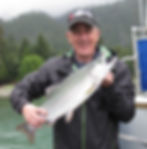Fishing for pink salmon in British Columbia
- The Trout Bandit
- Nov 24, 2023
- 3 min read
Updated: Dec 5, 2024

Fly-fishing the pink salmon run in the Pacific Northwest
I have been visiting British Columbia (BC) for two decades and it has become one of my preferred fishing destinations. On my first visits, I chartered boats to troll for salmon in Vancouver harbor with some success. But during the last decade or so, I have focused on fly fishing for steelhead, pink salmon and bull trout in the vicinity of Squamish and Whistler with Clint Goyette of Valley Fishing Guides. Clint first introduced me to the pink salmon run in 2009, and over the years he has put me on some sizable fish – including my first steelhead in April 2014 and, more recently, a personal best bull trout of about 7 pounds.
According to NOAA Fisheries, pink salmon are the smallest of the pacific salmon species and in the Pacific Northwest, the run of pink salmon extends from Alaska to the Sacramento River in California. This migration occurs every odd numbered year and is at its most prolific in Washington’s Puget Sound and Southwestern BC, with millions of fish making their way up the tributaries to spawn from around mid-July to early September.

Our trips to target ‘pinks’ usually encompass the tributaries that stem from the estuary (or inlet) of the Squamish River but also have included the rocky beaches of Howe Sound, where fish will hold up before embarking on the Squamish. Wading the rocky beaches around Furry Creek, you can see large groupings of fish idling in the gentle surf and awaiting accommodating tides to facilitate their migration into Squamish. At the peak of the surge, this location can be shoulder-to-shoulder with anglers - so arriving at the earliest point of an outgoing tide (if not before) is key to securing a good spot.
As the ‘run’ evolves, it is more advantageous to find yourself at the Squamish River or one of the tributaries, also at the outgoing (or ebb) tide. The fish generally are holding down river for the most advantageous point of entry (prior to low tide) and then migrate in waves upriver to find the appropriate spawning locations.

It is not unusual to see large numbers of fish holding in a spot, only to rush upstream as a group, which creates a visible change in current from the sheer force of the upstream run. It is also not unusual to see a pod of seals lingering in the current and ambushing these fish as they push upstream. When the upstream push simultaneously attracts attacking seals and multiple hook ups by anglers (possibly in competition), it is quite the sight!
In the past, I have found a 6/7 weight rod to be sufficient with a floating line and short leader from which a trailing streamer (purple, mauve or pink) can be very productive. This is particularly effective if the water is slightly discolored or if the fish are moving upriver in shallow water. If the water is deeper, it may take a sinking tip line to get to the fish.
A great tip that I learned from Clint as it relates to landing a fish that has been hooked up is to angle the rod to shore with the rod tip at the surface of the water. If the fish is properly hooked, it will be shaking (or splashing) its head on the surface. Once under control (in front of the angler), keep the pressure with an upright rod that is close in to net the fish. If foul hooked, which can happen often, the fish will take off in an indiscriminate direction. In this latter case, and assuming a barbless hook on the fly, attempt to jerk the fly out of the fish.
The 2023 pink salmon run started early and fish returned in numbers that exceeded initial forecasts for reasons not immediately known. But it is hoped that this trajectory will continue for the next few waves. Remember to observe BC fishing regulations, including the purchase of the appropriate type of license.
Tight lines.
